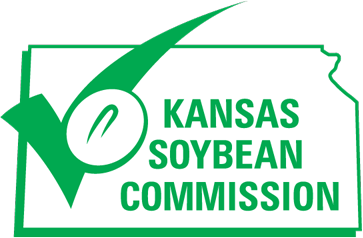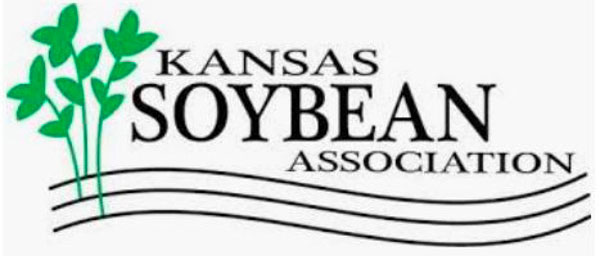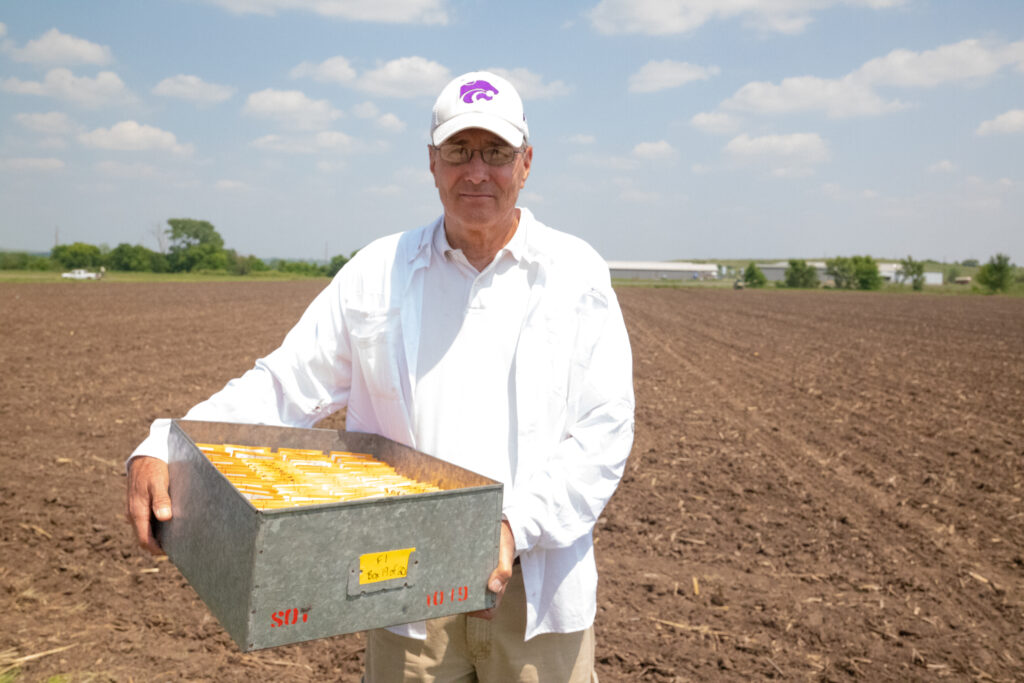No Slowdown for Schapaugh
It’s a balmy, slightly breezy afternoon in late May. Dr. William “Bill” Schapaugh and his team are doing what many across Kansas are – putting soybeans into the ground. But Schapaugh’s field of soybeans contains about two-thousand small plots testing soybean varieties.
“We have material in this plot that no breeders have ever used to develop a soybean variety,” Schapaugh says. “They are in the germplasm pool and we would like to see if they have useful genes. We want not only to improve genetic gain, but to maintain it. To maintain it, you need to have genetic diversity; genetic gain comes from finding the right genetic combination.”
Planting this field is a lengthy process that requires assistant scientist Rene, or another team member, to ride atop the four-row Kinze planter and drop packets of seed – each containing a different genotype – into a chute that splits into tubes running down to a revolving cone that drops the seeds into the ground. The packets need to be meticulously organized to ensure data accuracy throughout the growing season. Rene is also in constant communication with the team member in the tractor cab to be sure the information on the precision technology inside matches what she is dropping into the planter. The research team will be back to monitor the varieties throughout the summer.
It takes weeks, Schapaugh says, to prepare for planting this one field. It is one of many under Schapaugh’s supervision across K-State Agronomy land; one larger field south of Manhattan contains twelve-thousand plots.
“It takes us just a few seconds to plant a plot, but it takes a long time to get it ready and put in the right order,” Schapaugh laughs. It will take even longer to harvest each plot – about six times longer.
The research is working toward developing elite genes, which are what they sound like – the best performing variety based on the traits each genotype was bred for.
“We have a role in developing genetic base and genetic diversity and helping improve the germplasms that any breeder can use to develop new varieties,” Schapaugh says.
Cultivars developed at K-State that reach elite status can be used directly in commercial and conventional production. Schapaugh says he wants others to have access to their developments that is not restricted, but material transfer agreements are typically in place. They also receive royalties in some situations that route to the K-State Research Foundation.
Schapaugh’s team uses precision tools like remote sensing with rapid genome selection to improve phenotypes, or characterization, of the varieties in the field. They also utilize thermal sensing to record a different set of data. The goal is to use information collected to try to predict future performance of each variety.
Come harvest, the team is out in the field going through each plot individually collecting mature seeds and the data integrated within. They evaluate whether to keep or discard each set of seed; they keep most of it, according to Schapaugh. They have a specialized combine that can handle most of the harvesting, but there are some circumstances that require hand harvesting.
Schapaugh explains, “We have several thousand progeny rows, where every row is a different genotype that we have never evaluated before. We start out really small, so the row is only three to four feet long.”
Harvest is time- and labor-intensive, but it brings in the seed the team will be working with in the next growing season to build genetic gain.
“We start out with seed from one plant and if it continues to be evaluated, we continue to increase the quantity. Eventually, if it is something we want to release, we turn over bushels of seed to the Kansas Foundation Seed Project and they increase it to acres to get enough that could be used for commercial production.”
That is about an eight-year process, Schapaugh notes.
Creating a brand-new variety starts with hybridization, or crossing desired plant genetics in a greenhouse or field crossing block. Next, each progeny is evaluated. The goal is transgressive segregation, “we want something that is new and better than anything else we have,” Schapaugh explains. Schapaugh makes hundreds of crosses and, from those, thousands of progenies that are screened for desired traits.
There is hardly a slow season. When harvest is complete, Schapaugh and assisting researchers send seeds the greenhouse or winter nursery and by January are preparing for the next cycle of variety testing.
On top of balancing multiple breeding research projects, Schapaugh is big on collaborating with other university researchers, sharing findings in publications and seeking support from industry groups such as the Kansas Soybean Commission and North Central Soybean Research Program.
“Checkoff funding facilitates a lot of cooperation,” Schapaugh says. “We have material from other university breeding programs that we are evaluating for them and sharing those results with them. They are doing the same for us.”
This level of collaboration allows Schapaugh to be certain that the advanced material making its way toward commercial release is viable in other regions.
Schapaugh has been involved in soybean research since 1975, when he received a bachelor of science degree in agronomy from Iowa State University. He subsequently received his master’s degree and Ph.D. in plant breeding and genetics from Purdue University.
The Kansas Soybean Commission has been a long time investor in Schapaugh’s breeding research and germplasm creation.
Pictured above: Dr. Bill Schapaugh holds a box containing hundreds of soybean genotypes meticulously labeled and organized. These envelopes of seed will be planted in four-row by twelve-foot long plots in a field on the K-State Agronomy North Farm.


